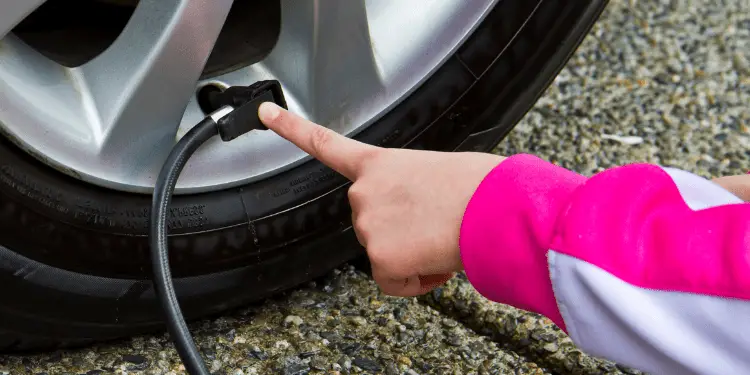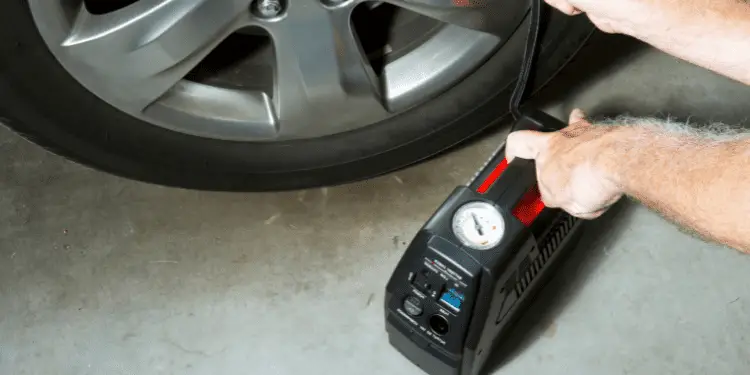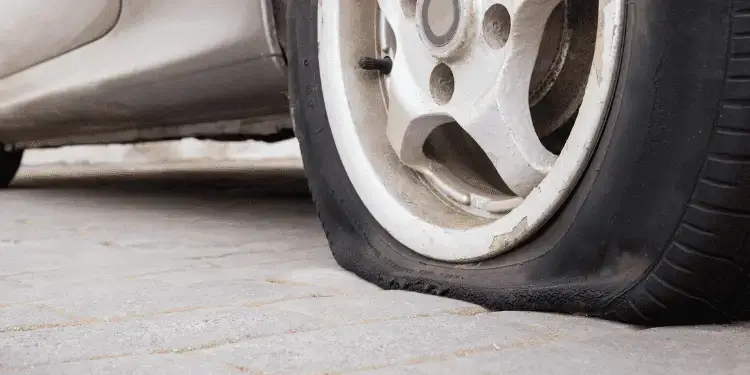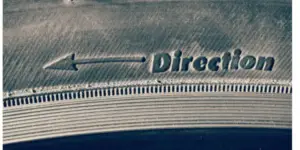It can put you in a bit of a quandary when you see that your tire looks slightly flat.
You wonder if it is safe to drive the car or whether you might be left stranded at the side of the road with a completely flat tire.
This article will cover how quickly air can escape from your tire naturally in different situations.
Briefly, though, before we get into the detail:
When driven regularly, a car tire in good condition will lose around two psi per month.
Therefore, if you haven’t checked your tires for three months and only just noticed that it looks slightly flat, this indicates normal air reduction in your tire. If your tire is flat and you didn’t notice a gradual decline, you have a leak, and adding air will only be a temporary fix.
There is only one way to check how much psi is in the tire: get a tire pressure gauge. Tire pressure gauges are often made with a compressor combined. So if you notice you have low air, you can top it up immediately by turning the compressor on and adding air.

Do Tires Go Flat More Quickly In Cold Weather?
Air temperature has a lot to do with tire pressure. Air molecules can become less active within the tire in very cold weather, causing fewer molecular collisions. This, in essence, means that they become less dense, and therefore the pressure inside the tire can drop quite significantly.
Generally, you can expect a reduction of 2 PSI for a decrease of 10 degrees Fahrenheit.
If you were to take a pressure reading from your car after a very cold night, you might find that the car has lost eight to ten psi.
Once driven, the pressure will rise as the air inside the tires warms by the tire’s friction against the road and the increase in daytime temperatures. This may increase the pressure back up to the recommended PSI for your tires.
In colder states, this can create a problem. The TPMS (Tire Pressure Monitoring System) will often trigger a dashboard warning light if the sensor detects a drop of 25% below the recommended tire pressure. If your tire was slightly underinflated already, this might be enough to cause a big enough drop in air pressure to trigger the low tire pressure warning light on the dash.

If this is the first real cold night you’ve had for a while, and it’s the first time the TPMS has activated, then the low temperature is the likely cause.
Signs That Your Tire Is Going Flat
There are a few signs that you can check for to see whether the decrease in pressure is due to standard reduction or whether you have an issue with your tire.
Tire Has Low Pressure Reading on the Gauge
The first one is to check the air pressure in your tire with a tire pressure gauge. You need to do this over two days. These readings will show whether the loss is normal or indicates a leak.
Take a reading on day one and at the same time on day two. You definitely have a slow leak if you see a drop of one psi or more.

If you were to leave this for a week, you would find that your tire would lose 25% approximately of the pressure it needs.
It’s important to use the same compressor and gauge on both days. It can be difficult with cheaper compressors and gauges to notice a one psi drop as they can be less accurate. The good news is that if you do have a leak, you would likely lose more than one psi in a day, so a leak should be very noticeable on the gauge.
When taking the reading, ensure that you take it at the same time of day and when the tire is cold. It’s best to do it in the morning as the tires will be cold and the tire pressure reading accurately.
If you need to take the reading at different times of the day, ensure the tire has been left stationary for at least an hour to allow it to cool down.
Poor Road Handling
Sometimes car tires can show very little signs of being underinflated, even at a seven to ten psi reduction.
However, you may notice that the handling is not as sharp as it was, especially if the leak is on a front tire and you have front-wheel drive.
Scuffs on Tire Sidewall
If your tire is very low on air, it will flatten and squash as you drive. This will cause a rubbing pattern on the tire sidewall.
This can be dangerous as the sidewall should never contact the road itself. It has no tread blocks and is only designed to support the tread.
If you see this, not only have you likely got a leak or have not filled your tire with air for some time. It is now dangerous and has been compromised beyond repair.
Small Decrease in Fuel Economy
Although you probably won’t notice, an underinflated tire will lessen fuel economy by one or two miles per gallon. Over time, it can add up to a few dollars you’ve spent needlessly.
How Far Can You Drive on A Flat Tire?
In an ideal world, it would be best if you didn’t drive on a flat tire. But we know this isn’t always possible.
When you drive a flat tire, you compress the sidewall, which causes rubbing against the road surface.
Furthermore, you’re very likely to cause damage to the rim because it is now in closer contact with the pavement.

If possible, you shouldn’t drive at all with a flat tire. It would be best to inflate it before driving or replace it with the spare from the trunk.
If this isn’t possible, you may be best advised to call a mobile tire shop to come out and fit a new tire.
You don’t want to have to replace the rim as well as the tire has. This could turn a fairly cheap tire replacement or patch repair into a more expensive rim replacement.
What’s the Minimum PSI Tire Pressure Should Read?
Most car manufacturers recommend that the psi be between 30 to 37 psi. However, driving your car without causing too much damage for shorter periods at around 20 psi may still be possible as long as you quickly top it up to the required and correct recommended pressure as soon as possible.
Many visitors also read this article: Tires Slashed or Normal Wear Signs [Answered]
Is It Dangerous To Drive on A Flat Tire?
It’s never recommended to drive with a flat tire. If you have to, you need to cut your speed down because the lack of air on the rubber will cause it to get extremely hot very quickly.
The tire may shred and fall off your rim, causing it to come into contact with the pavement itself. This will make your rim irreparable. Expensive damage can be caused to suspension and steering components as well.
Are Run Flat Tires Worth It?
Run-flat flat tires give you the peace of mind of knowing whatever happens to your tires; you can still get home or to a place of safety. The downside is you can expect to pay an extra 50% on top of the price of a standard tire. If you have a young family and are concerned about their well-being, sometimes the extra cost is worth the peace of mind that it gives you.
Financially it’s a difficult balancing act because although you won’t need to keep a spare tire in the trunk, run-flat tires are generally heavier than standard tires. The extra weight of four run-flats will cancel out the weight of not carrying a spare tire.
It’s also worth bearing in mind that a run-flat tire can not always be repaired as easily as a standard tire; therefore, you might have to replace them instead of getting them patched.




![Do Tires Lose Air When Parked For Long Periods? [ANSWERED] DEFLATED-TIRE](https://carzaza.com/wp-content/uploads/2023/12/DEFLATED-TIRE-300x150.png)


![Minor Dry Rotted Tires [GUIDE] Tire-veins-dry-rot](https://carzaza.com/wp-content/uploads/2023/12/Tire-veins-dry-rot-300x150.png)





